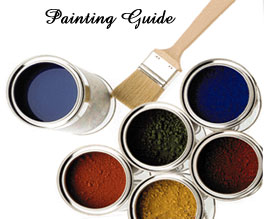 |
 |
Emulsion |
 |
|
Paint consists of:
-
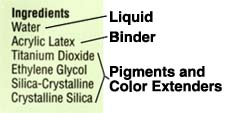
Check the percentages of solids in the paint. |
Pigments for color.
- Binders that hold the pigments together.
- Liquid that disperses and delivers the pigments.
- Additives that supply traits such as moisture resistance.
Pigments, binders, and additives are solids that stay on the painted surface.
The liquid evaporates (or cures). Product labels reference the percentages
of solids in paint. A higher percentage usually indicates a thicker, better
covering paint.
Two common types of paint are available:
Solvent-based (oil or alkyd)
- In oil-based paint, the liquid solvent is mineral spirits.
- Oil-based paint dries slower than latex — usually taking 24 hours to cure.
- Clean up with turpentine or paint thinner.
Water-based (latex)
- The liquid is water.
- An advantage to latex paint is that it dries relatively fast, which may or may not
be desirable in hot weather or direct sunshine.
- Clean up is faster, requiring only soap and water.
|
 |
|
 |
| Look for interior or exterior on the label. |
When painting indoors, use paint marked as "Interior" or "Interior/Exterior."
Exterior paint is not for indoor use. Plus it doesn't dry as quickly and
has a stronger odor — an important factor inside the house.
Sheen is the term used to describe the degree of light reflection a paint has.
Usually the less sheen an interior paint has, the less stain-resistant
it is. Different manufacturers may have various trade names for them,
but in general sheens are classified as "Gloss," "Semi-Gloss,"
"Satin" and "Flat."
- Gloss is the toughest. It's also an easier surface to clean, which makes it
a good choice for areas of high traffic or constant use. Gloss is most
often used on woodwork, baseboards, and kitchen and bath walls. Gloss
paint will, however, show imperfections in the surface more than other sheens.
- Semi-gloss paints are also durable and easy to clean, but have less shine than
gloss. They are just as suitable for woodwork, kitchens, baths, and
other high traffic or high-humidity places.
- Satin offers a good combination of easy-clean and moderate sheen.
- Eggshell is a smooth, low-sheen finish that has less sheen than satin.
It is ideal for living rooms, dining rooms, bedrooms and dens.
- Flat paint is considered non-reflective and a good choice for large wall
and ceiling areas. It also hides imperfections well and spatters less when applied.
If you want to change colors,
think about buying a small quantity of your color choice. Before purchasing
several gallons, paint a small area and wait a few days. Paints can react
to each other and cast reflections that may change the appearance of a
room. Colors may look different under various types of lighting or in
the sunshine. |
 |
|
A primer
will help paint adhere to the surface, providing a more uniform appearance.
Use a primer when painting over new wood, drywall, bare wood, or repainting
over existing bright or dark colors. Ask your salesperson and read the
laels before making this decision. |

|
|
The most important thing to know is the condition of the surface itself. Regardless
of whether the base coat is oil or latex, you must dull glossy paint by
sanding or de-glossing with a chemical de-glossing product. If you don't
dull glossy paint, the second coat will streak and not stick to the base coat when drying. |
 |
|
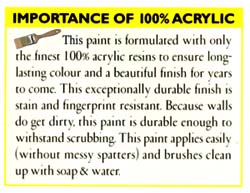
When reading the paint can, you may come across one or more of these interior paint terms:
- Hiding power — The ability of a paint to obscure or hide
the surface to which it is applied. Hiding power is provided by the
paint's pigment. Hiding power is affected by how thickly the paint tends
to apply and how well brush marks flow out.
- Adhesion — The ability of the paint to grip or adhere to a surface.
- Spatter resistance — The tendency of paint to throw off small
droplets during application, particularly by roller. Paints with good
spatter resistance are easier and more pleasant to use.
- Color acceptance — The development to its full intended color
whether application is by spray, brush or roller.
- Touchup — The capability of paint to produce the same appearance when used
for touchup as when the paint was originally applied.
- Stain resistance — The capability of the paint to resist retention
of household dirt and stains.
- Stain removability — The ease with which stains, dirt
or grime can be removed from the surface.
- Scrub resistance — The capability of the paint to maintain its
color when subjected to repeated washing or scrubbing.
- Burnish resistance — The capability of a paint to resist taking
on an increase in gloss or sheen when subjected to rubbing, scrubbing
or bumping an object against it.
- Block resistance — The capability of a paint, when applied to
two surfaces, not to stick to itself upon contact when pressure is applied.
Good block resistance helps keep a door or window from sticking.
- Print resistance — The ability of a paint to resist marking
or taking on the imprint of an object that is placed on it, such as a shelf with books on it.
|
 |
|
Surface preparation is critical if you want a quality paint job. The best paint money can
buy won't help if the substrate is not ready to accept it.
- Remove as much furniture as possible from the room. Group the heavier
items and cover them with drop cloths.
- Provide adequate lighting to allow a good view of imperfections.
- Remove switch plates and receptacle plates.
- Patch holes and cracks with premixed spackling paste. Sand patched areas when dry.
- Sand all rough spots. If paint has peeled or stained, moisture may be present.
Locate the cause and correct it. Then remove the old paint and prime the surface if required.
- Dust and wash the ceilings, walls, baseboards, window and door mouldings.
- Clean, sound wallpaper can be painted over, but in almost all cases it's best
to strip it. Remember that once you paint over wallpaper, you'll never be able
to remove it. If you do paint over it, test in an inconspicuous area
and wait a few days to see if the pattern bleeds through or the paper
begins to peel. A primer may be needed.
|
 |
|
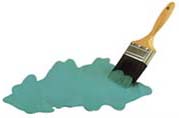
If you are painting the entire room, it's best to paint the ceiling first.
Ceilings
- Use drop cloths to cover furniture as well as the floor, carpeting and woodwork.
Paintbrushes sometimes drip and rollers emit a fine spray of paint that
settles over the room like dust.
- Start rolling the paint with a series of diagonal swaths (shaped like the
letter M). Fill in the open areas by cross rolling.
- If you use a brush, apply the paint in short strokes towards the unpainted
area, known as "wet to dry." Then brush back into the area
you just painted for a smooth surface.
- Remove light bulbs and fixture covers. Drop fixture covers by removing the screws.
- Paint trim first, including edging around the ceiling, moulding, and trim.
Walls
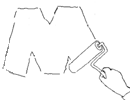
Proper "M" technique of painting will give you a smooth finish. |
- Paint around the trim first, including edging around the ceiling.
- When painting with a semi-gloss or high-gloss finish, make the final brush strokes
away from the light source in the room. The tiny ridges that a brush
leaves won't be as pronounced.
- If you use a roller, load the roller and apply the paint in a large M shape,
beginning in a corner near the ceiling. Fill in by rolling across the M.
- If you use a brush, use the same wet to dry method mentioned above.
- Apply high-gloss or semi-gloss paint in small sections that measure a few feet square.
Woodwork
- Check woodwork for damage. Patch with wood filler or putty. Let dry overnight,
sand any rough spots and apply a sealer before you paint.
- If you'll be using the same paint on the woodwork and walls, paint the woodwork
as you come to it. If it's another color or a higher gloss, wait until the walls are done.
- Paint double-hung windows starting with the wood between the panes, then work
outward. On casement windows, use the same technique, but keep the windows open slightly until the paint dries.
- For panel doors, paint the decorative molded edges first. Next, paint the individual
panels. Paint from the center out. When the panels are completed, paint
the flat vertical and horizontal panels.
- Use painter's tape or a painter's shield to keep paint off windowpanes. Wipe the paint
off the shield as you go. Always use painter's tape instead of masking
tape. Painter's tape allows you to keep areas covered for up to 3 days.
If you let masking tape stick around that long, you'll end up pulling off part of your finish.
- Paint the top edge of baseboards first, then the bottom along the floor. Paint the middle section last.
- Remove cabinet doors and drawers and paint the flat surfaces first. Paint inside
edges first, then move to the outer surfaces. Mark cabinet doors to
ensure they go back in the correct place.
|
 |
|
- Clean up as you go — the longer the paint sets, the more difficult cleaning
up will be. Use a cloth with soap and water or the correct solvent for cleaning.
- A razor-blade scraper or putty knife will chip off bigger paint droplets that have dried.
- Use a scraper to trim around windowpanes, trying not to break the seal between glass and paint.
- Wash and dry brushes and rollers. Store them according to manufacturer's recommendations.
|
 |
|
- Clean paint from the rim of the can. Tap container lids tight with a hammer and block of wood.
- Store solvent-based paint cans upside down to prevent a skin from forming.
- Avoid extreme heat or cold.
|
 |
|
- Disposal methods vary by community. Check your local environmental, health, and
safety laws.
|
 |
|
- Always provide adequate ventilation when painting. If you cannot get enough
ventilation in the work area, use a respirator.
- Keep containers closed when not using them.
- Keep paint products out of the reach of children.
- Avoid direct contact with skin.
- Follow label instructions for storing.
|
 |
|
|
 |
|
 |
|

